2022
April
29
|
iOptron mount shows incorrect RA and declination after successfully finding object
(Also posted on Cloudy Nights. I have corresponded with iOptron about this and confirmed it.)
One of the mysteries of my iOptron GEM45 telescope mount
(with 2021 firmware) is that it displays slightly incorrect RA and declination
of objects that it has successfully found and is tracking. Here's an example:
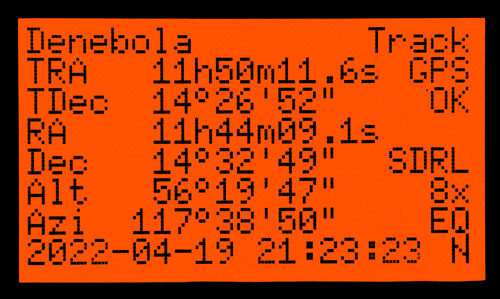
Here the TRA and TDec positions are the true (JNow) position of Denebola, which the telescope has found and is tracking.
If you glance casually at the other RA and Dec positions, you might guess they are
the position of Denebola for J2000 or some other epoch. No; the answer is much stranger. They are the coordinates of Denebola in the coordinate system the mount was using before you star-aligned. In this case, I did a good polar alignment followed by a one-star alignment, and the mount model (which I could view right after star-aligning) showed an offset of slightly over 1.5 degrees (6 minutes) in RA, as well as a small dec offset, both of which match the displayed discrepancy exactly. The mount was that far away from perfect zero position when it was turned on. Of course, we never start in perfect zero position, which is why we perform star alignment.
To make the discrepancy go away, sync on Denebola or any other celestial object. Unlike star alignment, a sync makes the mount actually discard the earlier coordinate system and use the current one. From then on, the displayed coordinates are as accurate as the mount's alignment allows them to be.
Going further — a sync is as good as a one-star alignment. As far as I can determine, a perfectly good way to initialize the mount is to do a good polar alignment (with iPolar or the like, arc-minute accuracy) and then go to a star and sync on it, with no actual star alignment at all.
Most mounts (Celestron, etc.) perform this sync automatically as the last step in any star alignment. After all, the old coordinates are no longer needed.
Also, more importantly, if you are sweeping visually and find something, you want to know its true coordinates so you can look it up in your star atlas or even report it if it's a comet. In that situation, there is no target object and hence no TRA and TDec (or rather they will be of the last object you went to, not the one you're looking at now). That is why I think iOptron's design decision is a mistake, and they should perform the sync automatically at the end of any star alignment. Until they decide to do that, it is important to sync your iOptron mount on the last alignment star (or any star) after star alignment.
I am hoping iOptron can be persuaded to reconsider this unfortunate design decision.
Why retain a coordinate system that is not needed for any purpose?
Note added 2023 March 22: In fact, in the latest firmware release, iOptron has dropped
one-, two-, and three-star alignment altogether, and they are advising people to initialize
the mount my way, by just going to an object, centering it, and syncing.
I am a bit disappointed that they simply abandoned the functionality rather than fixing it.
But it squares with my impression (not rigorously tested) that two- and three-star alignment were buggy
(in ways other than just displaying the incorrect R.A. and declination).
Permanent link to this entry
Signs of crackpot astronomy
(Also posted on Facebook.)
I've been encountering a lot of crackpot astronomy on Facebook all of a sudden. Here are themes to watch out for:
(0) Vagueness about who's saying it. Crackpot astronomy is posted by trolls (people who want to pick at us),
not by honest members of forums. Their names are often incomplete or false.
(1) Impossible sky pictures (moon in front of clouds, moon on horizon with no distortion from the air, moon upside down, etc.).
These could be intended as fantasy art, but if so, judge them as that, not as "nature photography."
(2) Taking NASA's name in vain. Hoaxes say "NASA says" something, but they don't ever link to NASA's web site.
There are even Facebook pages with "NASA" in their names that are not NASA.
(3) Claiming that some kind of big change could happen in the sky with hardly anybody noticing.
Folks, there is an army of astronomers, professional and amateur, making very precise observations all the time.
The sky isn't going to "shift around" without experts noticing immediately.
(4) Claiming that everyone who looks at the sky (even amateurs and observers in other countries)
relies on constant information "from NASA" which NASA could falsify,
or that NASA could somehow force or bribe us all to conceal or falsify something.
Permanent link to this entry


|
2022
April
27
|
Days lost to a pesky virus
Well, I meant to be back sooner! On the evening of the 19th, I took some astrophotos,
which I meant to post here. But I got busy, waited one day, and then, on the night
of the 20th, suddenly got very sick with a stomach virus, probably norovirus.
Not just me; the next day, Sharon got it, and Melody took her to urgent care, and they
called the ambulance! After lots of rehydration, she was better, but then Melody got it.
We are all recuperating now, still weak and eating restricted diets.
I had been planning to go to Deerlick — and to take Melody somewhere to do nature
photography — and to have some hobby time — but the main thing I did was sit
around, read and watch videos, and take care of Melody and Sharon. I'll probably be at home
for most of the rest of the week. Then I'll be backlogged with work.
Permanent link to this entry
M60, NGC 4647, and a supernova
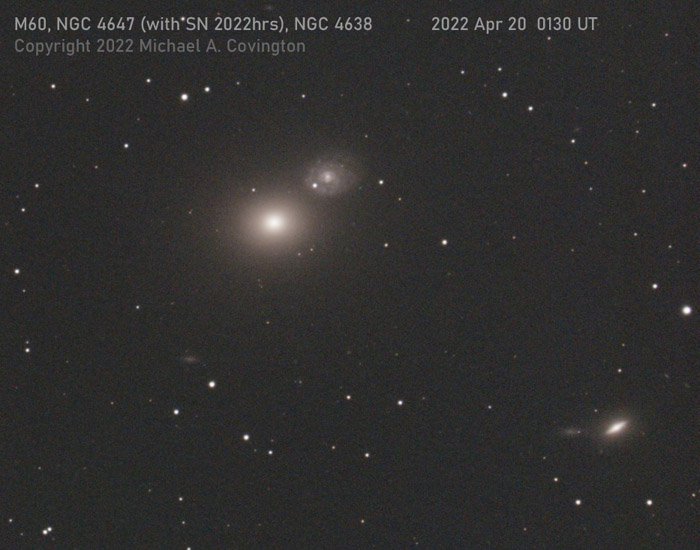
Here, finally, is the picture I took a week ago! The two brightest galaxies in it
are M60 and NGC 4647. On the outskirts of 4647, in the direction of M60, is a bright
star that is in fact a supernova. It was around magnitude 13.5 at the time but has,
I am told, brightened to 12.4 by now and is still brightening. If you're an astrophotographer,
you might want to see if you can catch it.
This is a stack of nineteen 2-minute exposures with my Celestron 8 EdgeHD, f/7 compressor,
and Nikon D5500 camera (H-alpha modified, ISO 200). The tracking was quite acceptable
using a guidescope and PHD2; I think this mount (iOptron GEM45) has had enough shakedown
and tuning that I can now rely on it.
This was my first imaging session controlled by BackyardNIKON, which was a delight to use.
Simply being able to focus on the computer screen, with quantitative readout of the
accuracy, was a very good thing. There were just two glitches. (1) For unknown reasons,
one of my 120-second exposures came out 132 seconds long and was not used. (2) Also for
unknown reasons, I couldn't get ASTAP to plate-solve under BackyardNIKON and confirm the
centering of the object. I first thought the problem was the supernova, but ASTAP had no
problem solving the same image by itself. I'll pursue these matters in the next session.
The session also yielded several other equipment- and software-test results, which I'll
write up (here or elsewhere) in the coming days.
Permanent link to this entry


|
2022
April
18
|
Easter successfully celebrated
I am delighted to report that both Melody and Sharon were well enough to go to church
with me on Easter, and then to host Melody's mother for an elegant late lunch in our
dining room.
It has been a long time! For 11 years Sharon has been suffering from a painful
nerve injury in her back and shoulder, and during that time, of course, Melody has
had 6 hip operations, and was at one point in a wheelchair for 5 months.
We are tired from yesterday's activities but glad to be this much closer to normal life!
Permanent link to this entry
Is COVID winding down?
Starting this week, Georgia will report COVID case numbers only on Wednesdays, and my daily
2:50 p.m. routine for the past two years will be gone.
Recently, a couple of other COVID sites stopped updating altogether.
91-DIVOC is still there, but of course it can't report data from the states more
often than the states deliver it.
What I want to see is a COVID spike that doesn't get off the ground — that is,
an upturn that fails to go very high.
Then I'll believe we're in the post-pandemic era.
Permanent link to this entry
Astrophotography with new software
This year's theme in my astrophotography is basically new software.
Now that I use the iOptron iPolar for polar alignment, I always take a computer with me,
which I also use for autoguiding with PHD2. So I am moving toward complete computer
control of the mount and camera.
I sold my Asus UX32A notebook computer (vintage 2013) and am doing all the telescope control
with the ThinkPad T490s that is also my "daily driver" for most home computer use.
I know this means I'm exposing a more valuable computer to risk at the observing site,
but it also means I'm using a computer that I keep updated all the time; I don't have to wait
for Windows to update almost every time I turn it on.
This weekend's step was to put aside the intervalometer that I use with my camera, and instead
control the Nikon D5500 from the laptop.
I do this with BackyardNIKON,
which
is excellent software, with only one big disappointment: the supplied user manual
is actually unfinished and out of date. Fortunately, online support is excellent,
and more to the point, the software isn't hard to figure it out.
I reviewed it already in Digital SLR Astrophotography but didn't get a permanent
license for it at the time. Now I have one, and I'm not going back. Focusing in live view
on the computer screen is much better than using the 2-inch screen on the camera.
Numerical measurements of focus are displayed, as well as a greatly enlarged image of the
center of the field. And I can set up exposure sequences conveniently. Files are downloaded
to the computer immediately rather than going onto the camera's SD card.
Here's what it looks like on the screen (from my 2018 test):
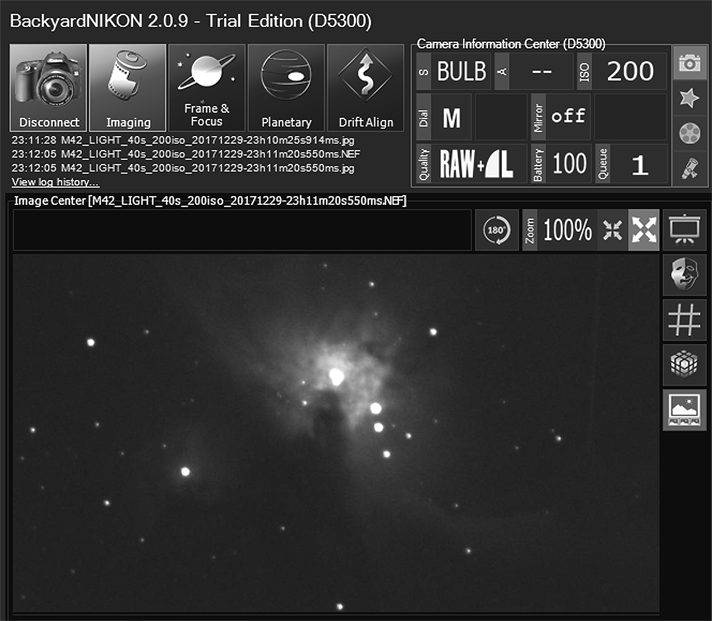
I've also installed
ASTAP for plate solving.
"Plate solving" refers to what astronomers at observatories used to have to do manually
with every photographic plate — figure out exactly where the telescope was aimed, which way in
the image is north, and determine the image scale — so that positions of objects could be measured.
Nowadays we solve digital images, not photographic plates, and it's done by software that
compares the image to a huge built-in star atlas.
BackyardNIKON interfaces to ASTAP, although this feature is only documented online, not in
the manual, and is fairly well hidden. (Connect BackyardNIKON to your mount and choose
Advanced Settings, I'm told. I haven't done this yet.) What it enables you to do is tell
BackyardNIKON what celestial object to photograph, and it will send your mount to the appropriate
place in the sky, take an image to confirm it, and adjust the mount as needed so that your
object is centered. I'm looking forward to this. Besides the obvious advantages, it will
apparently allow me to use J2000.0 positions, unadjusted for precession, so that I can type in
the object positions that are given in atlases and other reference books.
No; I still have to use epoch of current date.
BackyardNIKON also interfaces with PHD2 for autoguiding, and can perform dithering.
That is, before starting an exposure, it can tell PHD2 to stop guiding for a moment,
tell the mount to move a short distance in a random direction, and then tell PHD2 to
resume guiding. The purpose of this is to make sensor defects appear in random positions
rather than appearing in fixed positions or moving slowly in a straight line ("walking noise")
as the stars seem to shift slowly due to mount flexure.
I've tried about half of this and confirmed that it works. I have yet to try out dithering and plate solving.
Once I get all of that working well with BackyardNIKON, I plan to
move to N.I.N.A., which does the same things,
with some additional features such as polar alignment assistance, and works with a wide variety
of cameras, not just Nikons. Then I'll eventually move toward using a dedicated astrocamera
instead of a DSLR.
And through all this, there will be little change in what I can take pictures of.
I have to run as fast as I can just to stay in place!
Permanent link to this entry


|
2022
April
10
|
Perfume quest succeeded: Traquenard ≈ Popy Moreni
A few months ago I successfully obtained, for Melody,
a tiny bottle of the perfume
she had bought in Paris and was wearing when we first started dating.
Traquenard, by Marfay.
(It is no longer made.)
But what I got was a very tiny bottle — about 10 mL —
and its 50-year-old plastic cap disintegrated yesterday. We hastily decanted
what was left into another tiny bottle, and also undertook a quest.
We took it to the local perfume shop (Perfume Place, in Georgia Square Mall)
and asked the proprietor what is available today that is similar to it.
He sniffed it and said, in essence, "I know that one by another name,"
and pointed us to Popy Moreni (a perfume named after, and marketed by,
a fashion designer). Good match. In fact, Popy Moreni smells the way Traquenard
did when we first knew it, before aging for decades in the bottle.
Permanent link to this entry
A day out!
The COVID case rate in Georgia is so low that we had a relatively normal day today,
normal even by pre-COVID standards, and for us, a welcome respite from what I've been
calling "captivity."
Melody went with me to the Palm Sunday service at
Alps Road Presbyterian Church. We had missed the previous two; at least the first one
(2020) was not held at all; I'm not sure about 2021.
Then we ate lunch out, at Amici, across the street from FormFree on Macon Highway.
And then we went to the mall, where we went to the perfume store, and then I walked
while she shopped at Belk's. Just like old times, except that the mall is 2/3 empty
and is probably not long for this world. We fear this may end up having been our
last trip to it together.
Permanent link to this entry


|
2022
April
5
|
Barred spiral galaxy M95
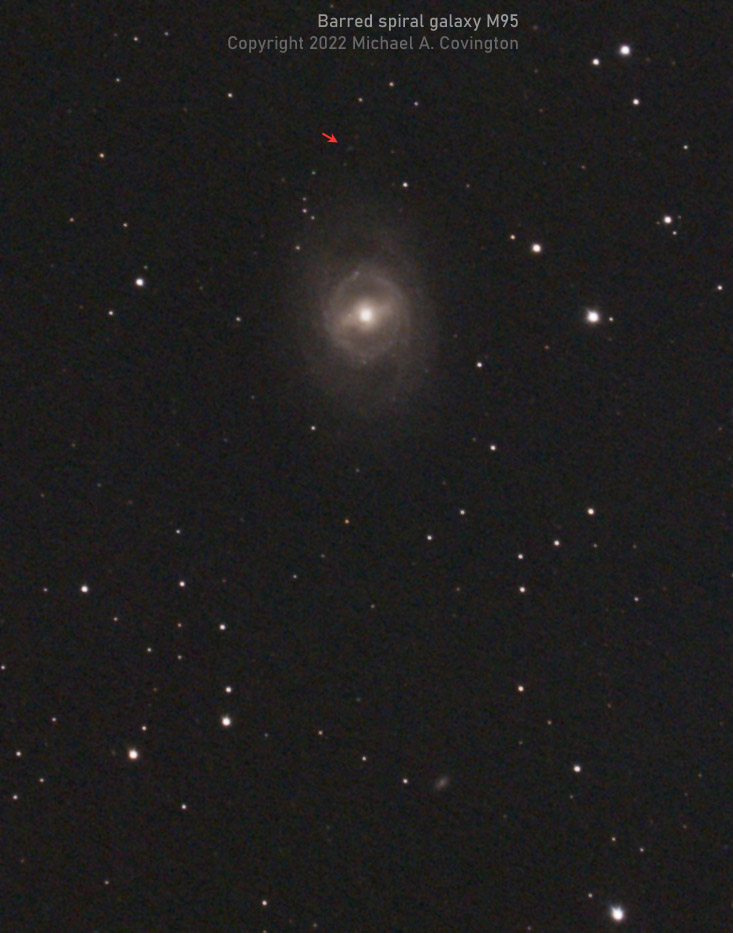
It's galaxy season. That is, the earth is in the portion of its orbit such that in the
evening sky, we are looking perpendicular to our galaxy, seeing fewer nearby stars and
more distant galaxies.
Here is M95, a barred spiral galaxy believed to be 33 million light-years away.
At the bottom, you can also see a more distant galaxy, the 15th-magnitude
galaxy Z 66-3, about which little is known. But what fills me with awe is that the
picture also shows quite a few very distant galaxies, barely visible; the red arrow
points to one of them, about which nothing is known except its position in
the sky. (Large observatory photographs confirm that it is a galaxy.)
All of these galaxies are about the same size — meaning there are countless
"island universes" as big as our own Milky Way, and so far away that we can't see them.
Back to M95. The bar and the spiral arms are not (primarily) gas or some foggy
substance; they are clouds of stars, or more precisely, places where the stars are closer together,
and relatively little is known about how they form. What is clear is that stars
are not tied to them; they are more like thick spots in a traffic jam, which can remain
thick in specific places as cars pass through and more cars enter.
Like most of what I do these days, this picture was first of all a test to make sure the
newest versions of the software, and the latest minor equipment modifications, still work.
It's a stack of sixteen 2-minute exposures with my Celestron 8 EdgeHD at f/7
and a Nikon D5300 camera body, autoguided with a 60×240 guidescope, ASI120MM-S guide
camera, and PHD2 guiding software. To get a better picture, I should expose three or
four times as many 2-minute "subs" as individual sub-exposures are called.
Permanent link to this entry


|
2022
April
3
|
"Errors in the Copernican Theory"
My 1972 science fair project
Fifty years ago right about now, I was at the Georgia state science fair in Athens,
exhibiting a project somewhat misleadingly titled "Errors in the Copernican Theory."
As far as I know, no written record of this project survives.
The main report was given away or discarded, without my involvement or consent,
in the late summer of 1972. So this blog entry will be my attempt to preserve it
for posterity.
It was not a great project; it was somewhat interrupted by my changing schools in
mid-year. Nor did I have any mentors; I was under the mistaken impression that I was competing
on what I could do totally by myself in one academic year, just like an exam.
Nor did I do the library work and use the secondary literature the way I should have.
But, in my defense, the secondary literature about Copernicus at the time was not very
good. History of science, as a field, started thriving in the late 1970s, and today there
are many books and articles that will tell you accurately what Copernicus was up to.
Back then, many books gave third-hand accounts of Copernicus, not entirely accurate.
I realize that in saying that, I am engaging in history of history of science.
How many more levels are possible?
What I did do, and what I advise all researchers to do, was to use my superpower — that is,
do what I can do and others can't. My superpower was the ability to read Latin. So, unaware of the English
translation of Copernicus
in the Britannica Great Books, I wrote to Harvard Observatory to see if their librarian
knew where to get a reprint of the Latin original; they referred me to Swets & Zeitlinger;
and I ordered the Johnson reprint, then waited for weeks for it to arrive while it was tied up
in a dock workers' strike.
That Swets & Zeitlinger brochure also advertised the
infamous 1970 reprint
of Petrus Apianus'
Astronomicum Caesareum (1540), the book full of mechanical gadgets made of paper.
(Infamous because in the 1970 reprint, they were not assembled authentically and did not
demonstrate the geometry they were supposed to.)
It was the highest price I had ever seen quoted for a new book, hundreds of dollars in 1972,
equal to thousands today.
Fortunately Copernicus only cost something like $25!
So, to get the scoop on Copernicus, I read his own words in his own book.
I can't say I followed all the geometry, but I did find out what he thought his own most
important ideas were.
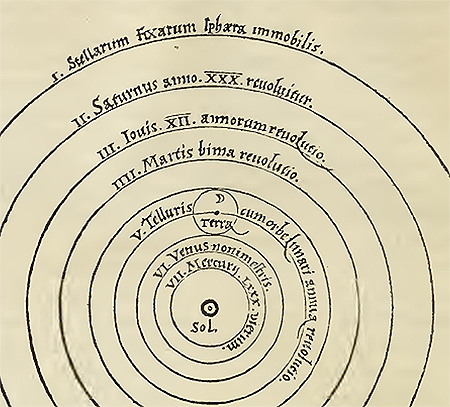
Copernicus was and is commonly credited with ending anthropocentrism,
the worldview that says we humans are in a special, privileged place in the universe.
My thesis was that he didn't actually do that — he only took a small step away from it.
I connected this, perhaps too closely, with a second and less controversial thesis, which is that
Copernicus did not abandon medieval astronomy and physics, but merely made a slight rearrangement.
His one big idea was that if you attribute an orbital motion to the earth, you get a simpler system
than if you handle the same motion separately as a component of the orbit of each of the other planets.
He was absolutely right about that, but he did not take the next step of considering that orbits might
not actually be (combinations of) circles. That's what the word "errors" in my title referred to.
Copernicus didn't get the shape of the orbits right.
For more technical information on how all this worked,
see what I wrote in January.
I no longer think Copernicus can be accused of "errors." He advanced science a certain distance and no further.
That was the correct move; by keeping his sun-centered system similar to Ptolemy's earth-centered system,
he limited the amount of it that could be disputed, and made it possible for his theory to gain followers.
He wasn't overturning physics as it was then conceived; maybe straining it
a bit because we don't feel the earth moving, but that was as much strain as it could take.
If he had tried to anticipate Kepler and Newton (even if he could have done so),
he would have been rejected as loony.
But I was right that he did not overturn anthropocentrism. He didn't even seem to be concerned about it.
In his system, we are still in the middle of the universe; it's just that we orbit around the central sun
rather than sitting in the very center. Some of his critics saw this as an assault on anthropocentrism
(often cast as an assault upon divine revelation), but as far as I could tell, Copernicus did not.
Not all of this was articulated very well in the project. But it did have one good illustration,
a picture of a retrograde loop in the orbit of Mars. There were no personal computers on which
to plot orbits back then, so I got permission to use Valdosta State College's Spitz A-3-P planetarium.
I set up a camera on a tripod and made a time exposure as I held the stars still but ran Mars through
part of its orbit.
I can't remember if we had a local science fair in Valdosta or if, as the only entrant from my school,
I proceeded directly to the regional fair in Brunswick. There, my project won second place but was
allowed to proceed to the state level. There it won second place again, which is all it deserved.
But I also got a special award from Georgia Power Company that sent me to the National Youth Conference
on Science and the Environment in Chicago in November 1972, my first academic conference (at which the
students did not present anything; we only had plenary sessions with speakers). One of the high points
of that trip, in turn, was getting to hear jazz legend George Shearing perform live at the London House.
Permanent link to this entry
Science fair +50
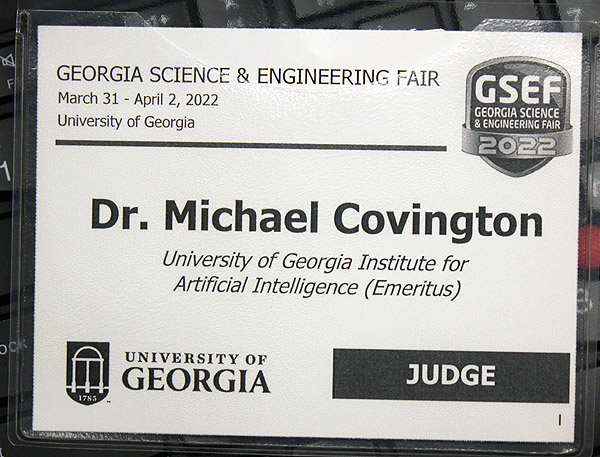
To mark the 50th anniversary of my participation in the Georgia state science fair, I volunteered
to be a judge for it this year (on Friday, April 1).
I was assigned the "Robotics and Intelligent Machines" section,
which comprised ten excellent projects — about which I will say nothing, because they have since
been through two more tiers of judging and have been given awards that I don't know about.
All I'll say is what I said to each student: "There are no losers here. Whether you win a prize or not,
you've done good work."
The thing that has changed most is mentoring. Many of the students were mentored by college
or university faculty and had some access to those institutions' labs. I am glad this is happening;
it's how science is done; the students learn far more;
I just hope the resources are available for all motivated students.
For what it's worth, I had no doubt that the students' projects were their own ideas; any that
weren't, would have been screened out before they got to state level.
This is something I didn't understand about science when I was in high school.
I thought that, like an exam or a musical performance, the science fair was purely about what
you could do totally on your own.
In any case, not a lot of mentoring was available to most students.
Superficially, two things that have changed since 1972 are that everybody has computers for
data collection and analysis, and desktop publishing technology to prepare neat-looking displays.
My display back in '72 was a motley mix of typewritten material, transfer lettering, lettering
with a Heyer drafting guide, and freehand calligraphy. And that was typical.
I was glad to be there. An interviewer asked me to look back on how the 1972 science fair changed
my life. My answer: "It was my first academic visit to The University of Georgia, and it set some
things in motion. I started thinking about what it would be like to study here. Eight months later,
I was here for a recruiting event, and a year later, I started as a student. Two years after that,
I went to the same recruiting event and recruited my wife, as both student and girlfriend, which
worked out conveniently. After going away to graduate school and a postdoc, I came back as a faculty member."
[Added:] The other important thing about that science fair is that, for the first time, I felt that I was
surrounded by my own kind of people — quick-witted, articulate, and scholarly — and didn't
have to seek out a few like-minded individuals and win their friendship in order to be able to
communicate with them. For a shy person like me, a congenial community was more important than a
set of close friends. Everybody was supportive of each other's scholarly inclinations;
nobody gave me funny looks for being intellectual, and we could all talk about things we were really
interested in, not just what other teens considered fashionable. Ever since, I've lived my life in such
communities whenever possible.
Permanent link to this entry
Ph.D. +40
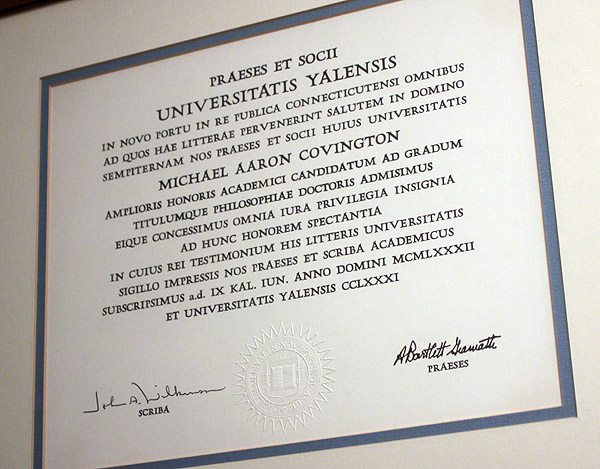
Yesterday (April 2) was the 40th anniversary of my last day at Yale; I stayed an extra day to
avoid finishing on April Fools' Day.
The previous day, I vacated my apartment (1145 Chapel Street, Apt. 603, a building known as El Dorado
that was about to be remodeled; I was one of the last residents to leave).
After spending the night in the Hotel Duncan next door,
I had breakfast with Doug Downing, got on the Connecticut Limousine, went to LaGuardia Airport,
flew to Atlanta, and joined my mother, my sister, and my beloved bride-to-be.
And that was Yale.
Permanent link to this entry
Galaxies M81 and M82
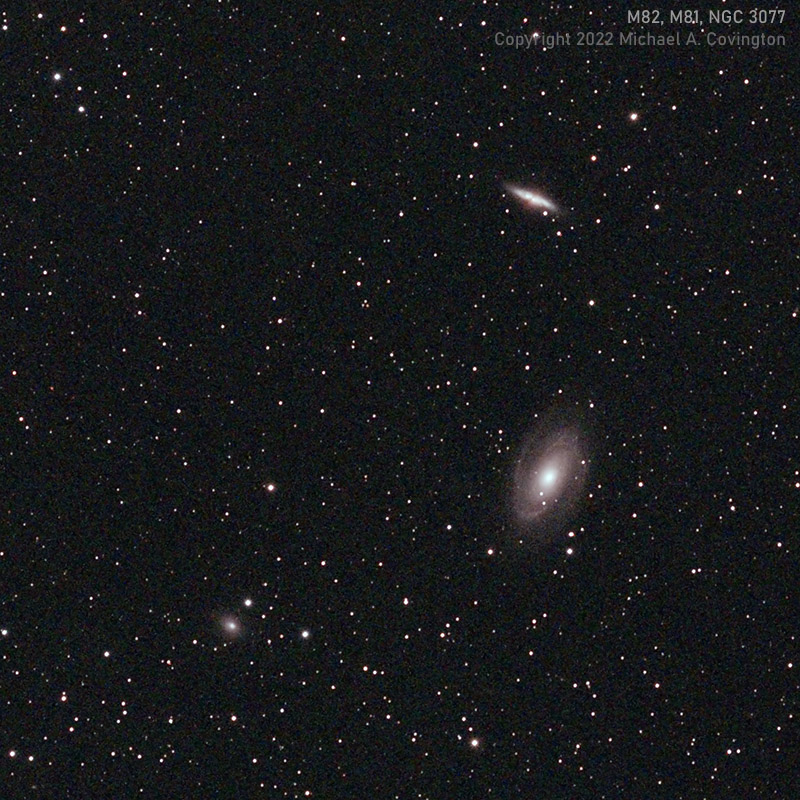
I've almost been too busy to do astrophotography, and meanwhile, the equipment and software change so
fast that a lot of time is spent simply making sure new configurations work as well as the old ones did!
There you see a stack of nineteen 2-minute exposures of M81 and M82 with a Nikon D5500 (H-alpha modified)
at ISO 200, on my GEM45 mount, in the driveway in Athens. The lens is an Askar 200/4 set (by mistake)
to f/4.5, with an Orion SkyGlow broadband filter installed. The question was whether the filter would
help bring out some of the reddish hydrogen bursting forth from the middle of M82 (the thin galaxy at the top);
you can definitely see some of it.
Having the guidescope attached to the mount is handy; it eliminates the problem of how to attach
it to a telephoto lens or small telescope.
For reasons of balance, I remove it when it's not being used. With the 8-inch telescope,
of course I use a larger guidescope.
Apart from minor software updates, the other change I was dealing with is that I've fitted an iOptron
iGuider guidescope and camera to the side of the mount's saddle. Since this is an early-model GEM45,
I had to drill and tap a couple of holes. Sharp-eyed readers will note that the saddle of the GEM45 is
backward, with the USB socket on the front; putting it on this way is a recommended option whenever
you need more space at the rear, for a telescope that sits fairly far forward, as mine does.
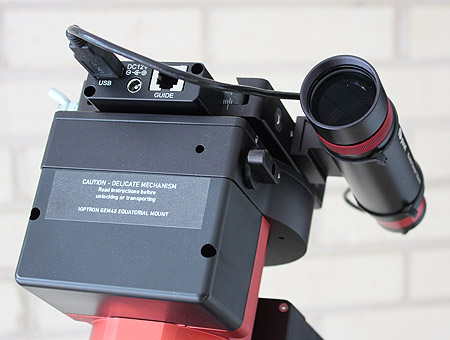
Permanent link to this entry


|













